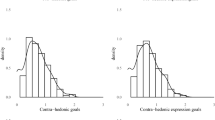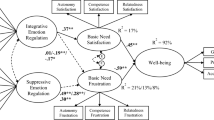Abstract
A system of values define how lay people behave and view the world. Critical to this system are the contrasting values of self-enhancement and self-transcendence, which differ in the degree to which they promote the pursuit of one’s own interests versus the interests of others. The present research investigated an alternative way of parsing emotion (valence x self-serving/other-serving) informed by these opposing values. In Study 1, findings from multidimensional scaling analyses supported the structural validity of self-and other-serving emotions. In Study 2, different groupings of self-and other-serving emotions were associated with interpersonally relevant traits. In Study 3, data gathered from informant report largely replicated findings regarding the importance of self-and other-serving emotions to individual difference variables. Further, self-serving and other-serving emotions were associated with self-enhancing and self-transcendent goals, respectively. In Study 4, using a daily diary design, experiencing self-serving emotions was most strongly associated with self-enhancing goals, whereas experiencing other-serving emotions was most strongly associated with self-transcendent goals.


Similar content being viewed by others
Notes
Common to almost all two-dimensional conceptualizations of emotion is the inclusion of the core dimension of positive versus negative valence, the validity of which is supported by an extensive body of research (e.g., Barrett & Russell, 1998; Larsen & Diener, 1992; Russell, 1980, 2003). Thus, alternative two-dimension emotion parsings share the dimension of valence (i.e., positive vs. negative), with differences between emotion parsings being accounted for by the dimension that is paired with the dimension of valence.
In total, each participant completed 4 sorting tasks for the emotion dimensions of valence, arousal, moral, and self/other. Due to the scope of this paper we only present results related to the dimension of self/other. Results regarding the arousal and moral ratings, as well as additional information regarding the study instructions and analyses, can be found in the supplemental materials.
When using the original emotion groupings without adding any emotion items from Study 1, the pattern of findings in Studies 2 and 3 were remarkably similar.
The associations between emotion groupings from all other emotion parsings and interpersonally relevant traits can be found in the Supplemental Material.
Additional findings of self/other parsed emotions providing incremental validity in predicting interpersonally relevant individual difference variables and goals can be found in the Supplemental Materials.
Some findings from data collected from this sample are reported in Chow, Berenbaum, & Flores, 2014. However, we present novel findings that have not been reported elsewhere. In addition to actual affect, the study measured the degree to which different emotions would have been useful to them in accomplishing their goals, findings of which are reported in Chow et al., 2014.
A table of findings that reports the association between self/other emotion parsing groupings and daily goals can be seen in the supplemental material. The pattern of results is remarkably similar.
References
Adler, M. G., & Fagley, N. S. (2005). Appreciation: Individual differences in finding value and meaning as a unique predictor of subjective well-being. Journal of Personality, 73, 79–114.
Algoe, S. B., Haidt, J., & Gable, S. L. (2008). Beyond reciprocity: Gratitude and relationships in everyday life. Emotion, 8, 425–429.
Bardi, A., & Schwartz, S. H. (2001). Values and behavior: Strength and structure of relations. Personality and Social Psychology Bulletin, 29, 1207–1220.
Beckes, L., & Coan, J. A. (2011). Social baseline theory: The role of social proximity in emotion and economy of action. Social and Personality Psychology Compass, 5, 976–988.
Borg, I., & Groenen, P. (1997). Modern multidimensional scaling: Theory and applications. Springer-Verlag.
Chase, I. D., Tovey, C., Spangler-Martin, D., & Manfredonia, M. (2002). Individual differences versus social dynamics in the formation of animal dominance hierarchies. Proceedings of the National Academy of Sciences, 99(8), 5744–5749.
Chow, P. I., & Berenbaum, H. (2012). Perceived utility of emotion: The structure and construct validity of the perceived affect utility scale in a cross-ethnic sample. Cultural Diversity and Ethnic Minority Psychology, 18, 55–63.
Chow, P. I., & Berenbaum, H. (2016). The relation between depression and appreciation: The role of perceptions of emotional utility in an experimental test of causality. Cognition and Emotion, 30(4), 797–806.
Clark, L. A., Simms, L. J., Wu, K. D., & Casillas, A. (2011). Schedule for Nonadaptive and Adaptive Personality—Second Edition (SNAP–2). University of Minnesota Press.
Conroy R. Sample size: a rough guide. Ethics (Medical Research) Committee; 2015. Retrieved from: http://www.beaumontethics.ie/docs/application/samplesizecalculation.pdf
Cordaro, D. T., Sun, R., Keltner, D., Kamble, S., Huddar, N., & McNeil, G. (2018). Universals and cultural variations in 22 emotional expressions across five cultures. Emotion, 18(1), 75.
Davison, M. L. (1983). Multidimensional scaling. Wiley.
DeSteno, D. (2009). Social emotions and intertemporal choice: “Hot” mechanisms for building social and economic capital. Current Directions in Psychological Science, 18, 280–284.
Ford, B. Q., & Gross, J. J. (2019). Why beliefs about emotion matter: An emotion-regulation perspective. Current Directions in Psychological Science, 28(1), 74–81.
Frijda, N. H. (1994). Emotions are functional, most of the time. In P. Ekman & R. J. Davidson (Eds.), The nature of emotion: Fundamental questions (pp. 127–130). Oxford University Press.
Goldberg, L. R., Johnson, J. A., Eber, H. W., Hogan, R., Ashton, M. C., Cloninger, C. R., & Gough, H. C. (2006). The International Personality Item Pool and the future of public-domain personality measures. Journal of Research in Personality, 40, 84–96.
Gray, K., & Wegner, D. M. (2011). Dimensions of moral emotions. Emotion Review, 3, 258–260.
Haidt, J. (2003). The moral emotions. In R. J. Davidson, K. R. Scherer, & H. H. Goldsmith (Eds.), Handbook of affective sciences (pp. 852–870). Oxford University Press.
Hughes, D. J., Kratsiotis, I. K., Niven, K., & Holman, D. (2020). Personality traits and emotion regulation: A targeted review and recommendations. Emotion, 20(1), 63–67.
Karnaze, M. M., & Levine, L. J. (2020). Lay theories about whether emotion helps or hinders: Assessment and effects on emotional acceptance and recovery from distress. Frontiers in Psychology, 11, 183.
Keltner, D., & Gross, J. J. (1999). Functional accounts of emotions. Cognition & Emotion, 13, 467–480.
Knutson, B. (1996). Facial expressions of emotion influence interpersonal trait inferences. Journal of Nonverbal Behavior, 20, 165–182.
Krach, S., Cohrs, J. C., de Echeverría Loebell, N. C., Kircher, T., Sommer, J., Jansen, A., & Paulus, F. M. (2011). Your flaws are my pain: Linking empathy to vicarious embarrassment. PLoS ONE, 6, e18675.
Lafit, G., Adolf, J. K., Dejonckheere, E., Myin-Germeys, I., Viechtbauer, W., & Ceulemans, E. (2021). Selection of the number of participants in intensive longitudinal studies: A user- friendly shiny app and tutorial for performing power analysis in multilevel regression models that account for temporal dependencies. Advances in Methods and Practices in Psychological Science, 4(1), 2515245920978738.
Larsen, R. J., & Diener, E. (1992). Promises and problems with the circumplex model of emotion. In M. S. Clark (Ed.), Review of personality and social psychology: Emotion (Vol. 13, pp. 25–29). Sage.
Leger, K. A., Turiano, N. A., Bowling, W., Burris, J. L., & Almeida, D. M. (2021). Personality traits predict long-term physical health via affect reactivity to daily stressors. Psychological Science, 32(5), 755–765.
Levenson, R. W., & Gottman, J. M. (1983). Marital interaction: Physiological linkage and affective exchange. Journal of Personality and Social Psychology, 45, 587–597.
Levenson, R. W. (1992). Autonomic nervous system differences among emotions. Psychological Science, 3, 23–27.
McCullough, M. E., Kimeldorf, M. B., & Cohen, A. D. (2008). An adaptation for altruism The social causes, social effects, and social evolution of gratitude. Current Directions in Psychological Science, 17, 281–285.
Moskowitz, D. S., & Coté, S. (1995). Do interpersonal traits predict affect? A comparison of three models. Journal of Personality and Social Psychology, 69, 915–924.
Ortony, A., Clore, G. L., & Collins, A. (1988). The cognitive structure of emotions. Cambridge University Press.
Parks-Leduc, L., Feldman, G., & Bardi, A. (2015). Personality traits and personal values: A meta-analysis. Personality and Social Psychology Review, 19, 3–29.
Posner, J., Russell, J. A., & Peterson, B. S. (2005). The circumplex model of affect: An integrative approach to affective neuroscience, cognitive development, and psychopathology. Development and Psychopathology, 17, 715.
Roberts, N. A., Tsai, J. L., & Coan, J. A. (2007). Emotion elicitation using dyadic interaction tasks. In J. A. Coan & J. Allen (Eds.), The handbook of emotion elicitation and assessment (pp. 106–123). Cambridge University Press.
Roberts, B. W., & Jackson, J. J. (2008). Sociogenomic personality psychology. Journal of Personality, 76, 1523–1544.
Rokeach, M. (1973). The nature of human values. Free press.
Rozin, P., Lowery, L., Imada, S., & Haidt, J. (1999). The CAD triad hypothesis: A mapping between three moral emotions (contempt, anger, disgust) and three moral codes (community, autonomy, divinity). Journal of Personality and Social Psychology, 76, 574.
Russell, J. A. (2003). Core affect and the psychological construction of emotion. Psychological Review, 110, 145–172.
Schwartz, S. H. (1992). Universals in the content and structure of values: Theoretical advances and empirical tests in 20 countries. Advances in experimental social psychology (Vol. 25, pp. 1–65). Academic Press.
Schwartz, S. H. (1994). Are there universal aspects in the structure and contents of human values? Journal of Social Issues, 50, 19–45.
Schwartz, S. H. (2012). An overview of the Schwartz theory of basic values. Online Readings in Psychology and Culture, 2(1), 2307–2919.
Schwarz, N., & Clore, G. L. (1983). Mood, misattribution, and judgments of well-being: Informative and directive functions of affective states. Journal of Personality and Social Psychology, 45, 513–523.
Sell, A., Cosmides, L., & Tooby, J. (2014). The human anger face evolved to enhance cues of strength. Evolution and Human Behavior, 35(5), 425–429.
Tangney, J. P. (2002). Perfectionism and the self-conscious emotions: Shame, guilt, embarrassment, and pride. In G. L. Flett & P. L. Hewitt (Eds.), Perfectionism: Theory, research, and treatment (pp. 199–215). American Psychological Association.
Tangney, J. P., & Fischer, K. W. (1995). Self-conscious emotions: The psychology of shame, guilt, embarrassment, and pride. Guilford Press.
Tangney, J. P., Stuewig, J., & Mashek, D. J. (2007). Moral emotions and moral behavior. Annual Review of Psychology, 58, 345–372.
Tracy, J. L., Shariff, A. F., & Cheng, J. T. (2010). A naturalist’s view of pride. Emotion Review, 2(2), 163–177.
Vazire, S. (2006). Informant reports: A cheap, fast, and easy method for personality assessment. Journal of Research in Personality, 40, 472–481.
Watson, D., Clark, L. A., & Tellegen, A. (1988). Development and validation of brief measures of positive and negative affect: The PANAS scales. Journal of Personality and Social Psychology, 54, 1063.
Wiggins, J. S. (1979). A psychological taxonomy of trait-descriptive terms: The interpersonal domain. Journal of Personality and Social Psychology, 37, 395–412.
Williams, L. A., & DeSteno, D. (2009). Pride: Adaptive social emotion or seventh sin? Psychological Science, 20(3), 284–288.
Zeelenberg, M., & Pieters, R. (2006). Feeling is for doing: A pragmatic approach to the study of emotions in economic behavior. In D. De Cremer, M. Zeelenberg, & K. Murnighan (Eds.), Social psychology and economics (pp. 117–137). Erlbaum.
Zeelenberg, M., Nelissen, R. M. A., Breugelmans, S. M., & Pieters, R. (2008). On emotion specificity in decision making: Why feeling is for doing. Judgment and Decision Making, 3, 18–27.
Author information
Authors and Affiliations
Corresponding author
Additional information
Publisher's Note
Springer Nature remains neutral with regard to jurisdictional claims in published maps and institutional affiliations.
Supplementary Information
Below is the link to the electronic supplementary material.
Rights and permissions
Springer Nature or its licensor (e.g. a society or other partner) holds exclusive rights to this article under a publishing agreement with the author(s) or other rightsholder(s); author self-archiving of the accepted manuscript version of this article is solely governed by the terms of such publishing agreement and applicable law.
About this article
Cite this article
Chow, P.I., Berenbaum, H., Boden, M.T. et al. All for one or one for all? Examining a parsing of emotion that is informed by lay people’s values. Motiv Emot 47, 333–346 (2023). https://doi.org/10.1007/s11031-022-10002-1
Accepted:
Published:
Issue Date:
DOI: https://doi.org/10.1007/s11031-022-10002-1




